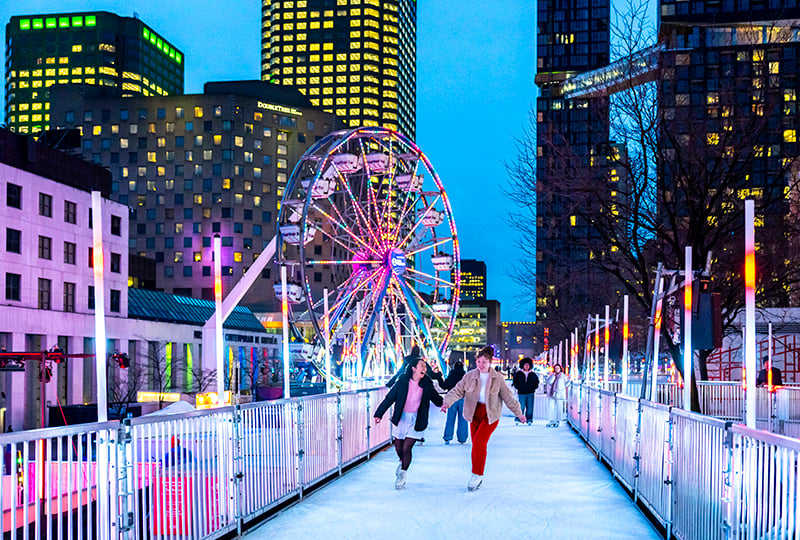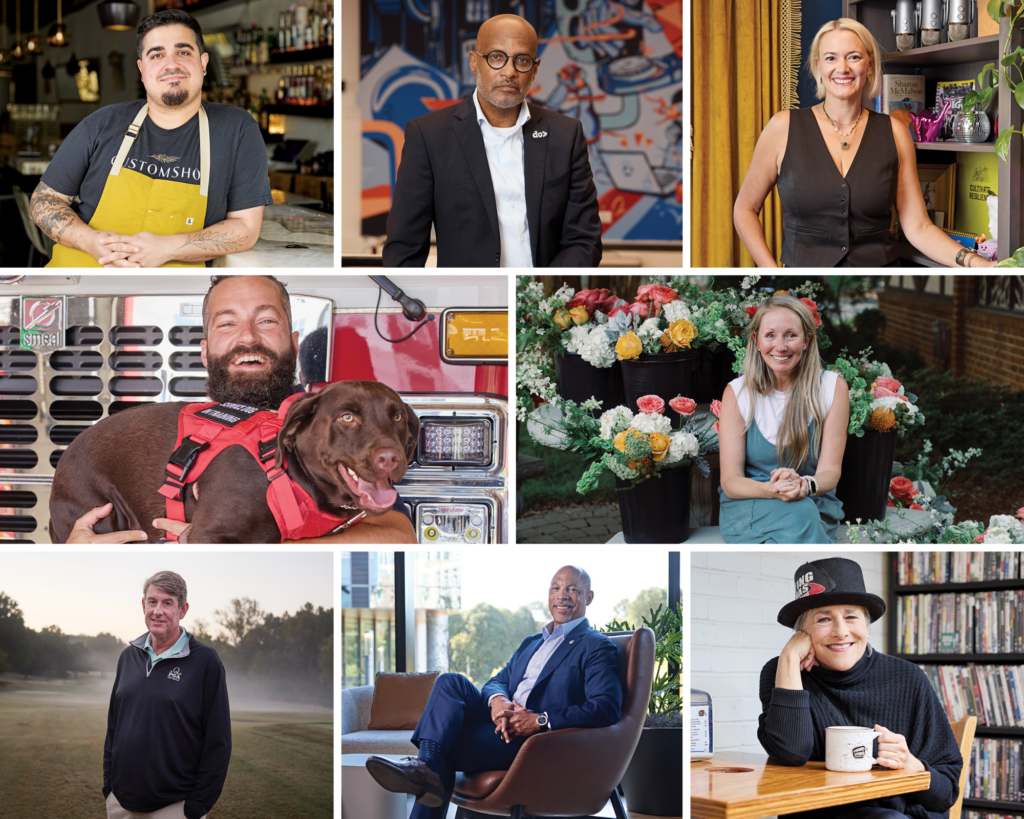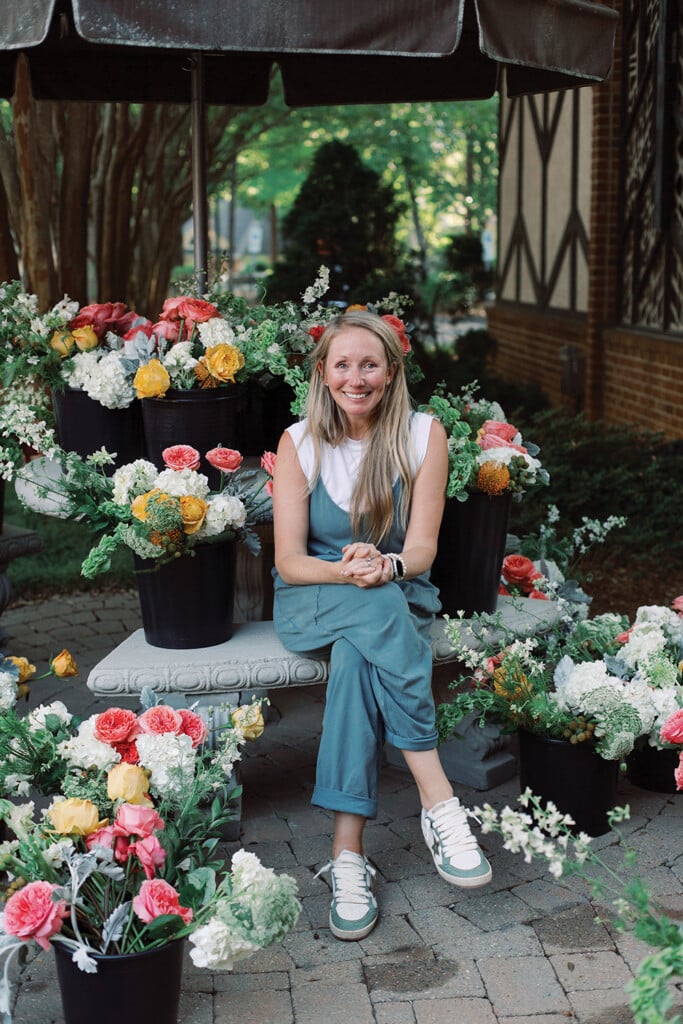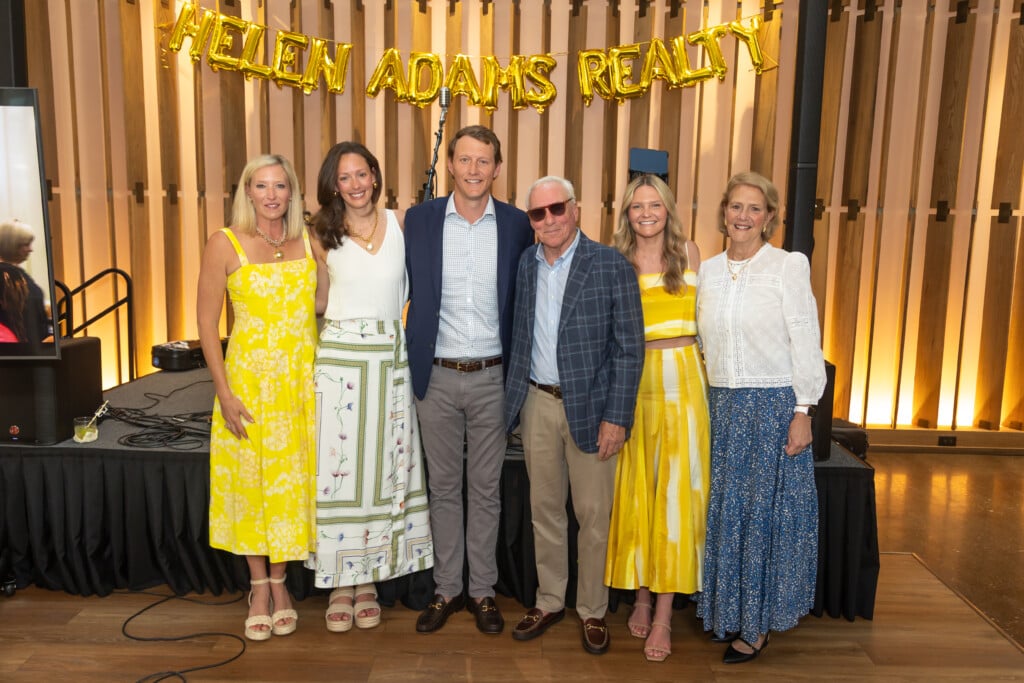Escape From Charlotte In Search of Snow: Quebec
Should you visit the province of Francophones, poutine, tart wines, and “sirop d’erable,” don’t overlook the Eastern Townships

A mist hangs over the grove of 1,000 maples on this cold, gray Sunday afternoon in early March. Silver buckets hang from the trunks. Our group of five is arrayed around a picnic table, where a handsome, white-bearded man in a Scotch plaid jacket pours dollops of syrup—”sirop d’erable”—onto a bed of snow in a plastic tray. This seems odd, wasteful: Arrêt, c’est bon sirop!
But this man, André Pollender, has a plan. Once the syrup has cooled to the proper viscosity, he draws from a box of wooden tongue depressors, dips the sticks into the semi-frozen puddle, winds the syrup around the tips, and hands one to each member of our party. They’re DIY syrup pops.
“Bon appétit,” says Béatrice Cadieux, one of our guides from the Eastern Townships’ tourism agency. This is us: outside in a Quebec village, surrounded by bare trees, temperature in the upper 30s, savoring globs of maple syrup on little wooden sticks. And it’s marvelous. We make “oh, that’s good” noises. André has explained that pure syrup—what he makes in his distillery, or “sugar shack”—contains healthful minerals and antioxidants. “It’s, like, good sugar,” Béatrice says.

Visitors to André Pollender and Danielle Cardin’s Cabane du Pic Bois get to sample chilled maple syrup, drawn from a grove of 1,000 on-site trees. Courtesy, Charles Dion
“It’s the best sugar,” André replies. I’ve taken the liberty of nicknaming him “Sugar Shack André,” although I do not tell him this.
“It’s not artificial sugar,” Béatrice says in her Quebecois-inflected, syntactically imperfect English, which is far more appealing than proper English. “In my coffee, me, I put maple syrup because it’s better sugar.”
This place is called Cabane du Pic Bois (“woodpecker’s cabin”), which André and his wife, Danielle Cardin, have owned and operated for nearly 30 years. It’s in the village of Brigham, about 50 miles southeast of Montréal and 15 miles north of the U.S. border—Vermont, the New England state with a French name. In 2019, André and his son, David, began to plant grape vines on the 124-acre property; they now have more than 17,000 along with a winery, and they began a wine-tasting program last year.
Quebec wine, with its tart, cold-weather minerality, is a valued commodity in Canada and elsewhere. But nothing touches the province’s well-earned reputation for its maple syrup: Quebec, on average, produces 72% of the world’s supply. This region, known as the Eastern Townships, is the province’s syrup-producing center. (The tourism agency that employs Béatrice lists “Seven Exceptional Sugar Shacks,” including this one.)
The Eastern Townships—Cantons de l’Est—has been a distinct tourism destination since 1850. It’s at the very bottom of the province and known to Canadians and New Englanders for syrup; wine; cheese; an emerging agritourism scene and farm-to-table dining options; outdoor recreation; and abundant natural beauty—but not so much to tourists from anywhere else. Most Quebec visitors gravitate to the big city, Montréal, or the somewhat smaller capital, Quebec City, to the northeast. Our tour group doesn’t miss out on city fun, mind you—before we decamp to the Townships, we ride the runaway snowmobile of La Nuit Blanche (“The White Night”), an all-night winter event and a highlight of the Montréal calendar.
But the Eastern Townships offers a more intimate, peaceful side of Quebec life and culture. “You can breathe, you can relax, eat, enjoy the fresh air,” Béatrice enthuses, “and it’s not that far from Montréal!” Over the course of a busy three days, the “Cantons” charm, inform, and feed the heck out of us, even after a couple of memorable days—and one memorable night—in the Paris of North America.
Regarding Montréal: I arrive some 22 hours late thanks to a series of mechanical and labor issues with my American Airlines flight, and that is all I intend to say about that. The next day, we meet Thom Seivewright, a voluble 45-year-old Montréal native, professional tour guide, and child of a Scots-Irish father and French-Canadian mother. “I always say,” he informs us, “that Montréal was founded by the French, financed by the Scottish—and the manual laborers were the Irish.”
During our walking tour of Old Montréal, we pass a pair of statues at opposite corners of the historic public square Place d’Armes: The English Pug and the French Poodle. An Englishman holds the pug as he casts a disapproving gaze at the Notre-Dame Basilica, a symbol of French culture, on one side of the square. At an opposing corner stands a Frenchwoman who holds her poodle as she scowls the other way at the main Bank of Montréal, built in the 1840s and a symbol of British power. The dogs, though, face each other and sniff, curious if a pug-poodle alliance might benefit both.

Montréal native Marc Andre J. Fortier’s The English Pug and the French Poodle, at opposing corners of Place d’Armes, represent the uneasy alliance of cultures in Quebec’s largest city. Courtesy, Joyce-Nelson
“It’s kind of the essence of Montréal today,” Thom says as we stalk through the square. “The people are like my grandparents. The dogs are like my parents. I’m like the bilingual puppy that came from the dogs.”
Montréal is an island city, positioned in the middle of the St. Lawrence River, which contributes to its insularity. More significantly, Thom says, it’s a border city: at the edge of urban and rural, industry and nature, French and British, summer and winter. South of it is the cacophony of the United States; north of it is some of the wildest land this side of Siberia. Europeans visit and say it feels American; Americans visit and say it feels European. Thom explains this as we take in an engraved-wood map of Quebec in Bonsecours Market, an indoor public market since the 1840s. “We have a feeling,” he says, “of being the last stop.”
I crave a last stop that night as we hustle from restaurant to cathedral to club to arts venue amid the throng that packs the streets for La Nuit Blanche. It’s a citywide winter festival of culture that began in 2003 and, once a year, keeps Montréal open all night for concerts, exhibits, shows, and winter sports.
Our guide for this evening is Olivier Lapierre, a tall, angular gentleman who works for Montréal en Lumière, the event’s organizing agency. We learn quickly that Olivier possesses immense enthusiasm for La Nuit Blanche, as evidenced by his walking speed of approximately 35 mph (56.3 kph in Canada). We’ve already walked all over town—including Mont Royal, the source of the city’s name and, you know, a mountain—and eaten lobster poutine, which ranks high on the list of richest things I’ve ever consumed. We stagger behind Olivier, who power-strides from destination to destination, block after block. “Olivier,” I croak. “Slow down, s’il vous plaît.” Non! Vite!
He does lead us, gasping, to some memorable destinations, like The AURA Experience, a spectacular 45-minute light-and-sound show at the Notre-Dame Basilica of Montréal; and PHI Centre, a multi-room, jam-packed warren of art, music, design, and technology. At midnight, two hours behind schedule, we hustle toward a metro station to catch another event. We’re just a few blocks from the hotel. I’m exhausted. I am unprepared for a nuit this blanche. I tap out. The day’s step count: 19,898.
I learn over breakfast the next morning that the hardy few who stuck it out rolled in at 2:30 a.m., and Olivier showed no sign of slowing down. We load up a van and drag ourselves into the Townships, where syrup awaits.
After the syrup comes the wine. We cross the road from the Cabane to the Vignoble (“vineyard”) for a tasting. Then, just for the heck of it, we tread back across to tour the old barn that contains the winery, its giant tanks filled with empty and unlabeled bottles and, on this day, shiraz. Outside, we encounter David Pollender with a light-russet chicken on his shoulder, the apparent product of our having crossed the road. “Name’s Fermiere,” David says. (“Farmer.”) “It’s a miniature chicken. An adult, but very, very small.” Fermiere, who seems alarmed, hides behind David’s head.
You could hardly paint a more rustic scene. But the Townships have cities, too. The biggest of its 114 municipalities is Sherbrooke, a city of about 170,000 at the region’s eastern end and considered the region’s unofficial capital. We don’t make it to the far smaller industrial city of Granby, an hour’s drive west. But we do end our sojourn in the region’s third-largest city and most popular tourist destination: Magog, population 28,000. Magog (pronounced “ma-GAHG”) perches at the upper tip of Lake Memphremagog, a 31-mile glacial gash that reaches south into Vermont.
Magog is where the first European settlers, American colonists loyal to the British crown, came from in 1776. It grew into a crucial steamboat stop in the early days and a textile manufacturing town in the 20th century. In recent years, as textiles subsided, it’s settled into a comfortable life as a resort town with a ready-made tourism hashtag (#OhMagog) and a main street, Rue Principale, lined with cafés, boutiques, and other small businesses. Imagine a long, lakeside, French-speaking NoDa.
It’s almost time to head to the Montréal airport. Scraps of leftover snow crunch beneath our boots as we stroll through Pointe-Merry Park, which juts into the blue-gray lake. Out on Memphremagog, which sports a carapace of ice even as spring approaches, a lone kite skater lets the wind pull him toward distant hills.

Mount Bromont is one of the Eastern Townships’ most popular destinations for skiers, many of whom stay at 166-room Hôtel Château-Bromont. Courtesy, Chateau Bromont
STAY
In Montréal, DoubleTree by Hilton provides a middle-of-everything base for touring the city; it’s part of Complexe Desjardins, a downtown shopping center with three office towers, 110 stores and restaurants, and a public plaza that hosts more than 200 events every year. In the Eastern Townships, the lodging options range from quaint, inexpensive bed-and-breakfasts to full-caliber resort hotels. Hôtel Château-Bromont’s 166 rooms sit at the base of Mount Bromont, one of the region’s most popular skiing sites in winter and a magnet for hikers and mountain bikers in warmer months. To the east, Magog’s many boutique hotels take advantage of their proximity to Lake Memphremagog: Hotel Verso, a retro-modern renovation of a 1950s motel, has wisely arranged most of its 54 rooms to face the lake and “the most beautiful sunsets in Quebec!”
EAT
Quebec’s an empty cupboard for cuisine. You’ll probably shed some pounds. (“Je plaisante” is French for “I’m kidding.”) Both Montréal and the Townships are cornucopias of astonishing dishes, from game-and-root-vegetable-centered Quebecois cuisine to Montréal’s famed smoked-meat sandwiches and, of course, poutine—the province’s official dish. A full accounting would take up a bookshelf, so I’ll highlight just two: St-Viateur Bagel, purveyors of Montréal’s distinctive, dense, large-holed bagels since 1957; and L’Espace Old Mill, a country-style restaurant—in a 175-year-old former hotel in the village of Stanbridge East—that ranked among AirCanada’s 10 best new restaurants in 2023. (As I savor my pasture-raised pork and Arctic char, a young, scruffy man approaches our table and asks how everything is. I assume he’s a friendly, perhaps tipsy diner. Then he introduces himself: Jean-Martin Fortier, the co-owner and a world-renowned organic farmer who tends the on-site garden.)

Once a year in winter, Montréal hosts La Nuit Blanche, a citywide night of concerts, exhibits, shows, and winter sports. Courtesy, Lake Memphremagog
PLAY
Again, too much to possibly list. For information about La Nuit Blanche (scheduled for March 1) and the two-week Montréal en Lumière festival, explore the Tourisme Montréal (mtl.org) and Montréal en Lumière (montrealenlumiere.com) sites; for the Eastern Townships, the region’s tourism site (easterntownships.org); and for the province overall, BonjourQuebec.com. One particular option worth mentioning, as it blends exploration with wine: La Route des Vins, a Quebec counterpart to Napa Valley that includes 23 vineyards (including the Pollenders’ Vignoble du Pic Bois), six road and four bike routes, and 16 restaurants.








